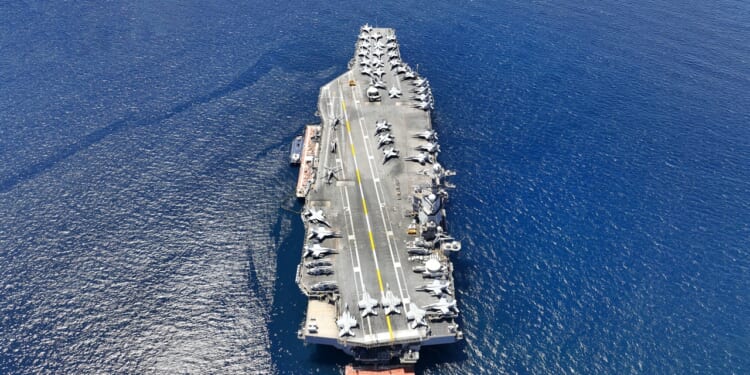The lead vessel of a new class of nuclear-powered supercarriers, USS Gerald R. Ford is currently the largest warship ever constructed in terms of displacement.
Following a deployment to the North Sea and the Arctic region, the United States Navy’s newest and largest nuclear-powered supercarrier, the USS Gerald R. Ford (CVN-78), transited the Straits of Gibraltar and was spotted operating in the Mediterranean Sea. It is the first time the warship has operated in the region since August, and it comes nearly two years after the warship’s 2023 deployment was twice extended as she was rushed to the eastern Mediterranean to deter escalation in the ongoing war in Gaza.
Tuesday will mark the second anniversary of the Hamas terrorist attack in southern Israel that saw more than 1,200 Israelis killed and hundreds taken hostage.
The Ford Has Had a Busy Year
CVN-78 departed her homeport of Norfolk on June 24. At the time, it was expected that she would be the latest US Navy carrier to be rotated to the Middle East to support Israel in the ongoing regional war and oppose the Houthis militants in Yemen. The carrier briefly operated in the Mediterranean, but then abruptly headed for the High North, where she took part in joint operations with NATO allies including Norway, Germany, and France—then joined with alliance members for the third iteration of Neptune Strike 2025 last month in the North Sea.
USS Gerald R. Ford had previously taken part in Neptune Strike-2 while she was deployed to the Mediterranean Sea in late August.
Even before the Hamas terrorist attacks, the United States Navy had maintained a carrier presence in the Mediterranean since early 2022, just prior to Russia’s invasion of Ukraine. CVN-78 returned to Norfolk in January 2024 following the eight-month extended maiden deployment. While at sea, the warship sailed more than 83,400 nautical miles, conducted 54 replenishments at sea, made 26 restricted water transits, and made five visits to foreign ports.
Following the deployment, USS Gerald R. Ford received the 2024 Battenberg Cup, which honors the top-performing ship in the US Fleet.
About the USS Gerald R. Ford
- Year Commissioned: 2017
- Length: 1,106 ft (337 m)
- Beam (Width): 256 ft (78 m)
- Displacement: ~100,000 long tons (112,000 t)
- Engines: Two Bechtel A1B PWR nuclear reactors; four propeller shafts
- Top Speed: ~30 knots (35 mph, 56 km/h)
- Range: Unlimited; approx. 25 years before nuclear refueling
- Armaments:
- Two RIM-162 ESSM launchers
- Two RIM-116 RAM launchers
- Three Phalanx CIWS systems
- Four Mk 38 25mm machine guns
- Four .50 caliber machine guns
- Crew: 4,539, including air wing
The lead vessel of a new class of nuclear-powered supercarriers, USS Gerald R. Ford is currently the largest warship ever constructed in terms of displacement. The total price tag for the vessel came in at $13.3 billion, nearly 30 percent higher than expected, despite facing numerous delays during construction and sea trials—so much so that the Pentagon hopes to avoid the same pitfalls with the future carriers of the class.
Built by Huntington Ingalls Industries’ (HII’s) Newport News Shipbuilding, the carrier is 1,092 feet in length and has a beam of 134 feet, while the flight deck is 256 feet wide. USS Gerald R. Ford displaces approximately 100,000 long tons and is powered by two nuclear reactors with four shafts, enabling the carrier to reach a speed in excess of thirty knots. Larger in size than the Nimitz-class carriers, the CVN-78 can operate with a smaller crew thanks to a greater emphasis on automation, and the carrier will also see a reduction in maintenance requirements, as well as a crew workload reduction. This will enable an improved quality of life for the crew, including better berthing compartments, larger gyms and workout facilities, and more ergonomic workspaces.
The carrier’s basic mission will remain unchanged. Yet the USS Gerald R. Ford will be able to deliver greater lethality, survivability, and joint interoperability, along with unmatched versatility and compatibility, as the joint-force transformation continues.
It was also reported that the US Navy can expect to save about $5 billion per ship in maintenance costs over the life of the program compared to the preceding Nimitz-class. The service had previously set a target of $4 billion in savings per ship. In addition, the Ford-class of supercarriers relies on greater automation, and the vessels were designed to operate effectively with nearly 700 fewer crew members than the Nimitz-class. The savings in operations and maintenance could free up money for other readiness and acquisition needs.
About the Author: Peter Suciu
Peter Suciu has contributed over 3,200 published pieces to more than four dozen magazines and websites over a 30-year career in journalism. He regularly writes about military hardware, firearms history, cybersecurity, politics, and international affairs. Peter is also a contributing writer for Forbes and Clearance Jobs. He is based in Michigan. You can follow him on Twitter: @PeterSuciu. You can email the author: [email protected].
Image: Shutterstock / Aerial-motion.















